Os dias de cartas formais e máquinas de fax já se foram há muito tempo. Até mesmo ligações telefônicas estão se tornando cada vez mais raras em ambientes de negócios. A era da comunicação pela Internet trouxe consigo uma dependência de ferramentas de colaboração digital para fazer os locais de trabalho funcionarem sem problemas.
A tecnologia de colaboração agora também é indispensável para a colaboração em equipe em muitos tipos diferentes de organizações. Na verdade, essas tecnologias hoje são a base do compartilhamento de informações, comunicação diária, gerenciamento de projetos e tarefas — todos os quais são componentes fundamentais da colaboração eficaz em equipe.
Este guia detalhará algumas das funções e benefícios do uso da tecnologia de colaboração. Além disso, daremos uma olhada nos recursos mais proeminentes de habilitação de colaboração, alguns tipos específicos de ferramentas de colaboração, bem como maneiras de medir seu sucesso. Por fim, planejamos observar algumas das tecnologias de colaboração emergentes e o que podemos esperar delas no futuro, além das tendências atuais no uso da tecnologia de colaboração.

O que são tecnologias de colaboração e o que elas fazem?
Tecnologias de colaboração são ferramentas e sistemas que usamos para habilitar e facilitar o trabalho em grupo. Esta é uma definição muito ampla que, tecnicamente, inclui ferramentas como código Morse e máquinas de fax. Então, temos que enfatizar que este guia estreitará seu foco em tecnologias de colaboração digital modernas e promissoras.
As tecnologias de colaboração usadas hoje funcionam fornecendo espaço e recursos para ajudar a melhorar a produtividade da equipe.
Elas fazem isso por meio de:
- Auxílio no processo de organização de conhecimento e metas;
- Acompanhamento do progresso;
- Fornecimento de canais de comunicação entre os funcionários.
Que tipo de valor a tecnologia de colaboração tem para as empresas?
O que você pode ganhar ao implementar a tecnologia de colaboração na sua organização? Bem, muitas coisas. De acordo com uma pesquisa da Queen’s University em Ontário, alguns dos benefícios comprovados da tecnologia de colaboração incluem:
- Aumento da criatividade e inovação nas organizações;
- Potencial para economia de custos;
- Aumento da eficácia do trabalho em grupo;
- Número significativamente expandido de parceiros potenciais e expertise disponíveis para uma empresa;
- Melhor acessibilidade e transparência de informações;
- Melhor ambiente de trabalho e liderança;
- Forças de trabalho fluidas, facilitadas e tomadas de decisão rápidas.
Esses benefícios combinados constituem um argumento convincente para o uso da tecnologia de colaboração no seu local de trabalho.
🎓 Se você quiser analisar mais detalhadamente o tópico sobre por que a colaboração em equipe é tão valiosa, confira nosso guia detalhado sobre Os benefícios da colaboração em equipe.
Colabore perfeitamente no Pumble
6 Elementos conceituais que compõem o ciclo de colaboração digital
O ciclo de colaboração digital é composto por seis elementos, todos os quais podem ter um impacto significativo no fluxo, na natureza e nos resultados de uma instância colaborativa. De acordo com a pesquisa, esses elementos incluem o seguinte:
- A tarefa colaborativa em si;
- A tecnologia usada;
- Os indivíduos envolvidos na tarefa colaborativa;
- As representações mentais que esses indivíduos têm;
- Os ambientes físicos e sociais em que se encontram.
1. A tarefa colaborativa
Este elemento é bastante autoexplicativo, apontando para a tarefa em questão, que requer colaboração para ser resolvida.
🔶 Exemplo:
Mia é contadora e está recalculando a folha de pagamento mensal de Rick, um membro da equipe de desenvolvimento de software que foi promovido recentemente. Ela sabe que ele estava planejando se mudar há algum tempo, então precisa verificar com ele os detalhes sobre seu local de residência e informações pessoais semelhantes.
2. Tecnologia de colaboração
Dentro do termo tecnologia de colaboração, incluímos o meio de comunicação criado pela tecnologia, bem como os recursos da tecnologia projetados para dar suporte à colaboração.
🔶 Exemplo:
To contact Rick, Mia sends a direct message to his Pumble team chat app profile. In it, she asks questions regarding his address and contact information. All Rick has to do is type out his response, and he can stay sure his personal information is securely handled.
3. Os indivíduos envolvidos na tarefa
Este elemento se relaciona com as pessoas diretamente envolvidas em esforços colaborativos para resolver a tarefa atribuída. O número de pessoas envolvidas, bem como suas características pessoais, afetam o processo de colaboração.
🔶 Exemplo:
Os dois indivíduos envolvidos nesta tarefa são Mia — a contadora, extrovertida e animada e fã de futebol, e Rick — o desenvolvedor de software introvertido com grande interesse em ciclismo. O fato de haver apenas dois participantes nesta troca, ambos entendendo muito bem a tecnologia usada e não tendo conflito direto de personalidade, torna o processo fácil e direto.
4. Representações mentais dos indivíduos envolvidos
Em termos gerais, esse elemento se refere ao contexto social e ao conhecimento que as pessoas têm em relação à tarefa colaborativa. Isso significa que pessoas que possuem esquemas mentais semelhantes têm mais facilidade para colaborar. Por outro lado, pessoas com uma grande lacuna de conhecimento terão que se esforçar mais cognitivamente.
🔶 Exemplo:
Mia já enviou inúmeras mensagens desse tipo antes, então ela tem uma compreensão sólida de quais informações exatas ela precisa. Além disso, como esse é um procedimento bastante rotineiro, Rick sabe exatamente como responder. Então, neste caso, tanto Mia quanto Rick têm representações mentais semelhantes da tarefa, permitindo que eles colaborem sem problemas.
5. O ambiente físico que cerca os indivíduos
O ambiente físico em que uma pessoa está pode afetar a maneira como ela aborda tarefas colaborativas.
🔶 Exemplo:
Mia trabalha no escritório, onde tem seu próprio espaço para poder se concentrar. Por outro lado, Rick trabalha em casa, onde as responsabilidades diárias podem atrapalhar o trabalho. Então, se seu filho pequeno aparecer com um pedido urgente de atenção, ele pode atrasar um pouco para enviar ou responder uma mensagem.
6. O ambiente social que cerca os indivíduos
Este elemento do ciclo de colaboração digital se relaciona com a influência social sob a qual os participantes estão. Essa influência vem na forma de atitudes, opiniões e comportamentos expressos por colegas, supervisores, clientes e outras pessoas.
🔶 Exemplo:
Mia costumava usar e-mail para esses tipos de tarefas, mas mudou para o Pumble depois que uma colega disse que achou mais fácil, rápido e seguro. Rick geralmente prefere a comunicação cara a cara, mas, neste caso, ele acredita que digitar informações para evitar mal-entendidos é mais conveniente.
Quais tipos de tecnologia podem ser usados para dar suporte à colaboração?
Existem diferentes características de acordo com as quais podemos categorizar tecnologias de colaboração. Elas incluem se ocorrem em tempo real, onde são hospedadas e qual é sua função.
1. Categorizado pela existência de defasagem de tempo
Vamos começar com a categoria que lida com quando a comunicação acontece. Especificamente, fazemos uma distinção entre tecnologias que operam com e sem a existência de atraso de tempo. Aqui temos dois tipos principais: tecnologia síncrona e assíncrona.
Tecnologia síncrona
A tecnologia síncrona ocorre em tempo real. Não há atraso percebido entre o momento do envio e o momento do recebimento da mensagem. Por exemplo, ferramentas de videoconferência são peças de tecnologia síncrona.
Tecnologia assíncrona
Quando se trata de tecnologia assíncrona, há um lapso de tempo entre o momento em que uma pessoa envia a mensagem e o momento em que o receptor a interpreta. Um exemplo desse tipo de tecnologia é o e-mail.
🎓 Se você quiser saber mais sobre as vantagens e desvantagens da comunicação assíncrona, visite este link para nossa postagem no blog sobre o tópico “O que equipes remotas precisam saber sobre comunicação assíncrona”.
Comunique-se de forma assíncrona pelo Pumble
2. Categorizado pelo local de hospedagem
Aqui temos uma lista de diferentes tipos de hospedagem, categorizados dependendo da infraestrutura usada para hospedar a tecnologia colaborativa.
Tecnologia de colaboração no escritório
Estas são as ferramentas instaladas, gerenciadas e mantidas em servidores físicos localizados em suas instalações. Como tal, é comum que as ferramentas de colaboração no escritório só possam ser usadas — no escritório ou dentro das instalações da empresa.
Tecnologia de colaboração hospedada na Web
Quando os dados do software de colaboração são armazenados em um servidor da Web, temos um caso de tecnologia hospedada na Web. Dentro deste tipo, há opções de hospedagem adicionais, como hospedagem compartilhada, gerenciada, dedicada, servidores privados virtuais, etc.
Tecnologia de colaboração hospedada na nuvem
Quando a ferramenta colaborativa é armazenada na nuvem, ela pode ser compartilhada pela Internet, o que aumenta significativamente a facilidade de acesso. Este tipo de tecnologia é especialmente conveniente para equipes remotas, pois pode ser acessada de qualquer dispositivo com conexão à Internet.
🎓 Intrigado? O recurso a seguir fornecerá tudo o que você precisa saber sobre os canais de comunicação que você provavelmente usará no trabalho.
3. Categorizado pela função primária
Neste segmento, listaremos tipos notáveis de tecnologia de colaboração, de acordo com sua função — para que foram feitos.
Espaços de trabalho online
Os espaços de trabalho online agrupam várias ferramentas, como e-mail e chat, fóruns de discussão, ferramentas de videoconferência, etc. Eles são eficazes para melhorar a colaboração porque centralizam e colocam em um só lugar diferentes ferramentas necessárias para tarefas diárias de trabalho.
🔶 Exemplo:
Espaço de trabalho do Google — uma ferramenta que fornece um e-mail personalizado para sua empresa e inclui ferramentas de colaboração como Gmail, Agenda, Meet, Chat, Drive, Docs, Sheets, Slides, Forms, Sites e outros.

Aplicativos de bate-papo em equipe
Um aplicativo de bate-papo em equipe permite que você troque mensagens de texto e arquivos on-line em tempo real. Dessa forma, as conversas permanecem relevantes e atualizadas. Precisando apenas de uma conexão de Internet no seu telefone ou computador, um aplicativo de bate-papo em equipe é uma maneira simples e eficaz de aumentar as taxas de colaboração produtiva entre os membros da equipe.
🔶 Exemplo:
Pumble — um aplicativo de bate-papo em equipe gratuito com usuários ilimitados e histórico de mensagens.
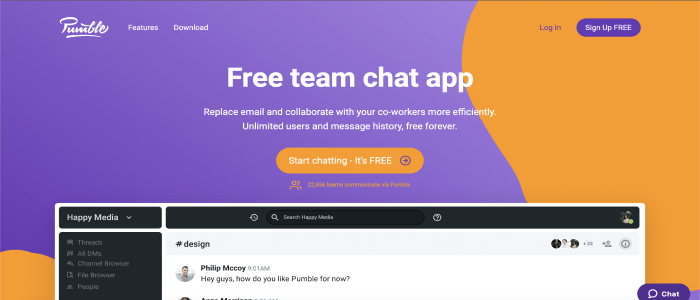
Use o Pumble para melhorar a comunicação da equipe
Software de gerenciamento de processos
Um software de gerenciamento de processos permite que os usuários planejem, gerenciem e monitorem o desempenho de vários processos no ambiente de negócios. Além disso, esse tipo de software é usado para automatizar tarefas de rotina e facilitar o fluxo de informações entre departamentos e funcionários.
🔶 Exemplo:
Nintex — uma ferramenta de gerenciamento de processos e automação de processos.
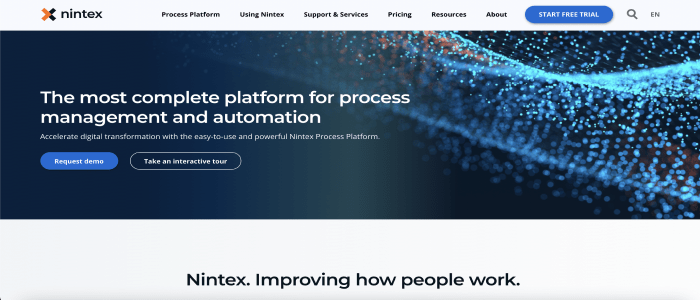
Ferramentas de gerenciamento de projetos
O software de gerenciamento de projetos tem a capacidade de habilitar o planejamento, a organização e o gerenciamento de ferramentas de recursos, bem como desenvolver estimativas de recursos. Este tipo de software fornece maneiras eficazes de acompanhar e entregar projetos no prazo.
🔶 Exemplo:
Trello — um aplicativo de criação de lista de tarefas baseado na web, no estilo Kanban.

Software de compartilhamento de arquivos
As ferramentas de compartilhamento de arquivos permitem que você transfira arquivos de vários tipos, como software, documentos, vídeos, arquivos de áudio, etc. Você pode distribuir esses arquivos para todos os membros da equipe, usando configurações que limitam o acesso a membros selecionados da equipe.
🔶 Exemplo:
Google Drive — um serviço de armazenamento e sincronização de arquivos.
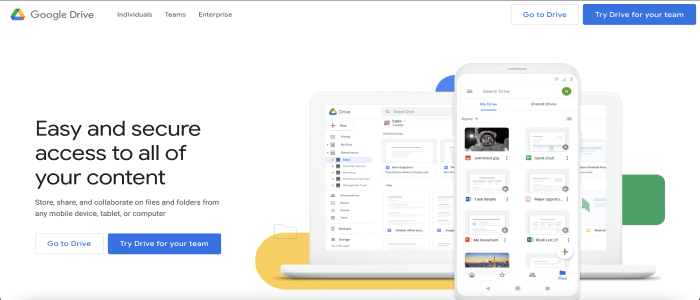
Ferramentas de gerenciamento de conhecimento
Ferramentas de gerenciamento de conhecimento são uma variedade de softwares usados para coletar, armazenar e acessar informações. Esses são sistemas que as empresas usam para compartilhar informações, tanto interna quanto externamente.
🔶 Exemplos:
Document360 — uma ferramenta de gerenciamento de conhecimento poderosa, mas fácil de usar.
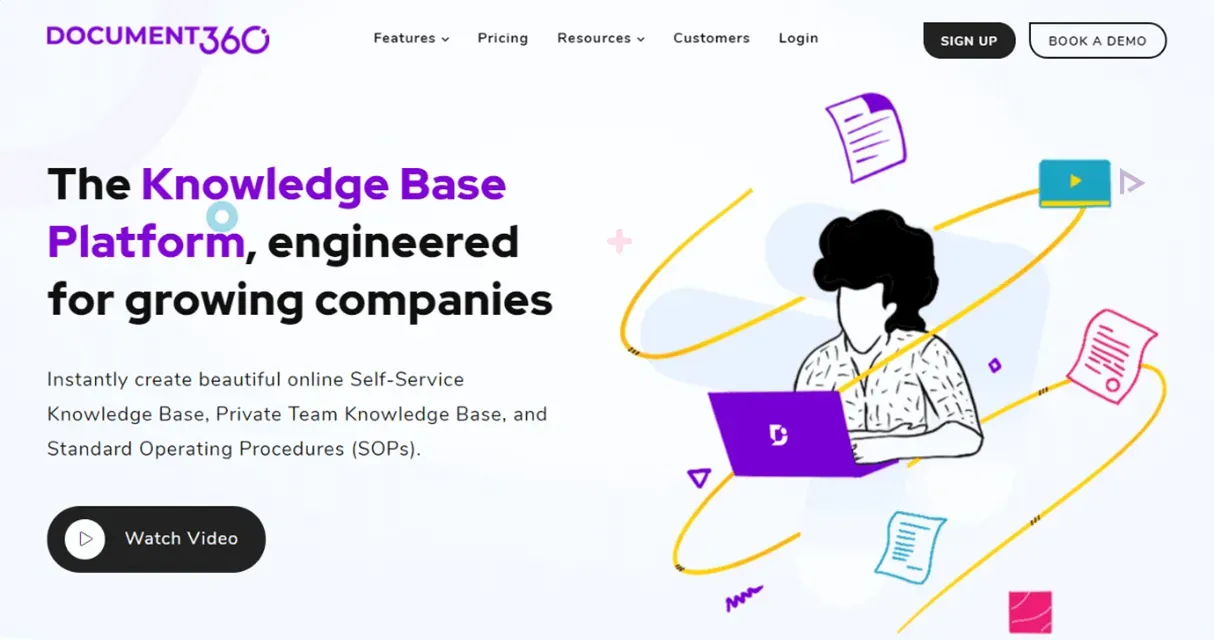
Confluence — um wiki corporativo baseado na web.
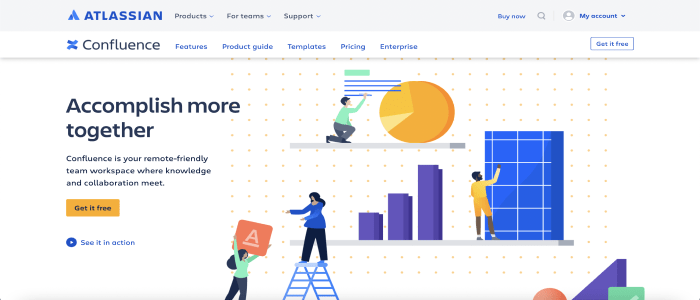
Ferramentas de compartilhamento de calendário
Uma ferramenta de calendário compartilhado economiza tempo ao facilitar a organização de compromissos e reuniões sem a necessidade de consultar todos os participantes. O organizador do evento pode verificar quando os participantes pretendidos estão disponíveis e escolher um intervalo de tempo de acordo.
🔶 Exemplo:
Google Calendar — uma ferramenta de gerenciamento de tempo e agendamento de calendário.
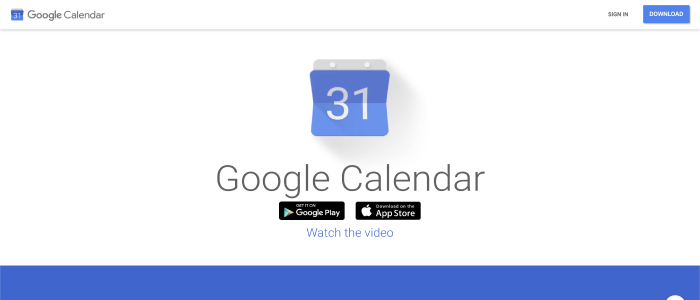
Quadros brancos digitais
Um quadro branco on-line é um análogo ao quadro branco clássico. Ao usar esta ferramenta, os membros da equipe podem se comunicar por meio de texto e informações visuais, incluindo desenhos e gráficos.
🔶 Exemplo:
Miro — uma ferramenta de quadro branco online gratuita.
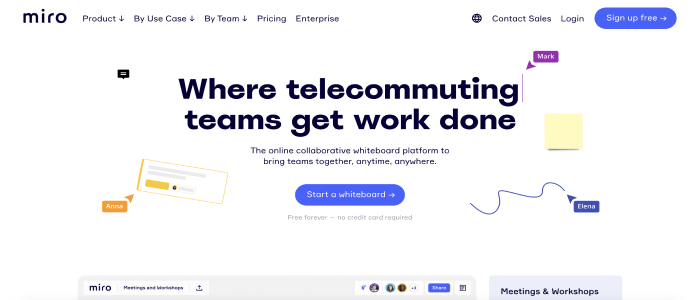
Ferramentas de videoconferência
Essas ferramentas oferecem uma maneira de se comunicar em tempo real, usando vídeo e áudio. Além disso, as ferramentas de videoconferência permitem que várias pessoas de vários locais participem da conferência. Dessa forma, as pessoas conseguem ter alguns dos benefícios das reuniões presenciais, sem precisar compartilhar o mesmo espaço físico.
🔶 Exemplo:
Zoom — uma plataforma de videoconferência que oferece suporte a reuniões, bate-papo, telefone, webinars e eventos online.

Precisa de uma ferramenta de conferência? Experimente o Pumble
Quais recursos da tecnologia de colaboração aprimoram a colaboração?
Neste segmento, usaremos o exemplo do Pumble, um aplicativo de bate-papo em equipe, para mostrar recursos de tecnologia de colaboração projetados especificamente para aprimorar a colaboração entre os membros da equipe.
Vamos dar uma olhada em uma lista de alguns desses recursos de tecnologia de colaboração.
1. Canais de bate-papo públicos e privados
Por exemplo, canais públicos em um aplicativo de bate-papo de equipe podem ser usados para comunicar conhecimento e compartilhar atualizações relevantes com todos os funcionários da empresa.
Por outro lado, você pode selecionar e adicionar manualmente pessoas a canais de comunicação privados, se quiser ter uma conversa confidencial com elas.
🔶 Exemplo:
A captura de tela a seguir mostra uma conversa ocorrendo em um canal privado do Pumble. Isso significa que apenas membros adicionados manualmente por pessoas com autorizações apropriadas podem acessá-lo. Então, o que Catherine e Irene estão falando neste exemplo só pode ser visto por outros membros do canal "estagiários".
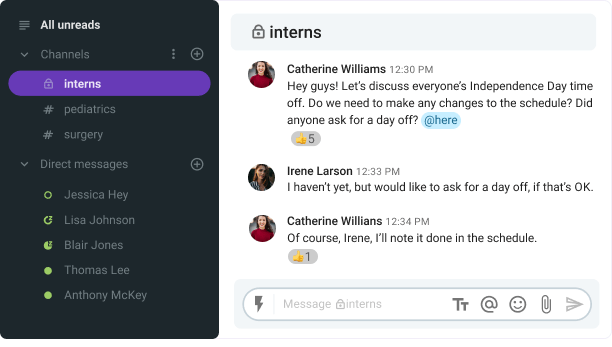
🎓 Dê uma olhada em nossa lista de canais essenciais para aplicativos de bate-papo em equipe. Este link levará você a uma postagem de blog onde pode encontrar algumas ideias úteis e criativas para canais do seu aplicativo de bate-papo em equipe.
2. Menções de membros da equipe
Esta ferramenta permite que você mencione membros da equipe, para que eles saibam que uma mensagem é direcionada a eles. Os membros da equipe recebem uma notificação de onde e por quem foram mencionados. A maioria dos softwares permite que você mencione um, alguns ou todos os membros em um canal específico.
🔶 Exemplo:
Neste próximo exemplo, vemos uma conversa acontecendo entre membros de um canal chamado "plano-de-campanha". Aqui, Stella menciona primeiro Jessica e John, perguntando se eles concordam com o público-alvo e o orçamento propostos. Essas menções enviam notificações para Jessica e John, e podemos ver que eles respondem à pergunta em minutos. Jessica menciona Xavier, direcionando Stella a ele para obter detalhes sobre os números específicos para dados demográficos.
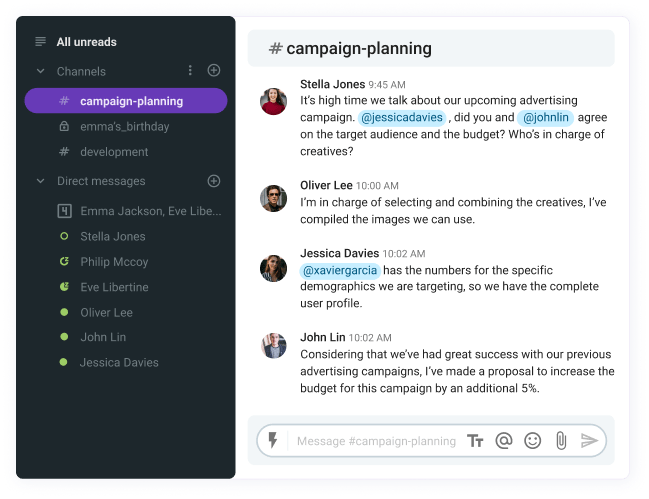
3. Visibilidade de status e configurações de notificação
Visibilidade de status é outro recurso útil, permitindo que os membros da equipe informem aos outros se eles estão disponíveis. Combinado com notificações inteligentes, que você pode pausar e silenciar, você pode criar mais facilmente um espaço de trabalho produtivo.
🎓 Se você quiser algumas dicas sobre como nunca perder atualizações importantes, dê uma olhada em nosso artigo “Como não perder mensagens importantes em conversas em grupo”.
🔶 Exemplo:
A captura de tela que fornecemos a seguir mostra várias opções de status e notificações que Jemma pode escolher. Ela pode até atualizar seu status com um pequeno emoji, explicando-o melhor de uma maneira divertida, mas perspicaz. Vemos aqui que Jemma está ativa no momento, mas suas notificações foram pausadas.
Além disso, vemos um exemplo de uma notificação que Jemma recebe quando ela é mencionada junto com Marco e Phillip.
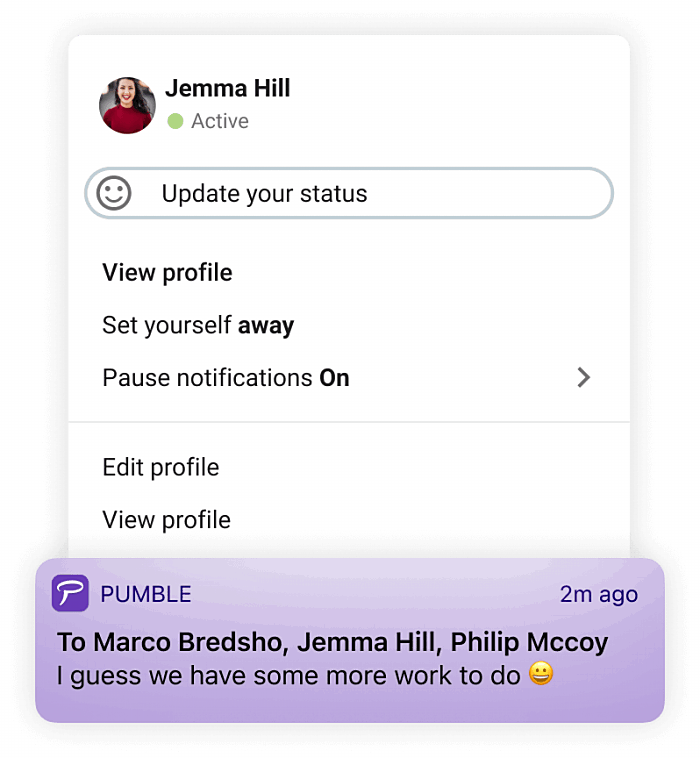
4. Histórico de bate-papo e pesquisa
Se você puder pesquisar seu histórico de bate-papo, terá uma maneira simples de retornar a conversas importantes e obter confirmação sobre decisões anteriores. Especialmente úteis são as opções de pesquisa e compartilhamento de links diretos para mensagens anteriores, acessando arquivos antigos. Essas opções são habilitadas pelo histórico de bate-papo ilimitado, que permite que você sempre tenha acesso a essas informações importantes.
🔶 Exemplo:
Aqui vemos que Jemma digitou "vídeo" na barra de pesquisa, o que permite que ela veja todas as conversas anteriores que incluem essa palavra-chave. As opções de navegação facilitam ainda mais a localização exata do que ela estava procurando.
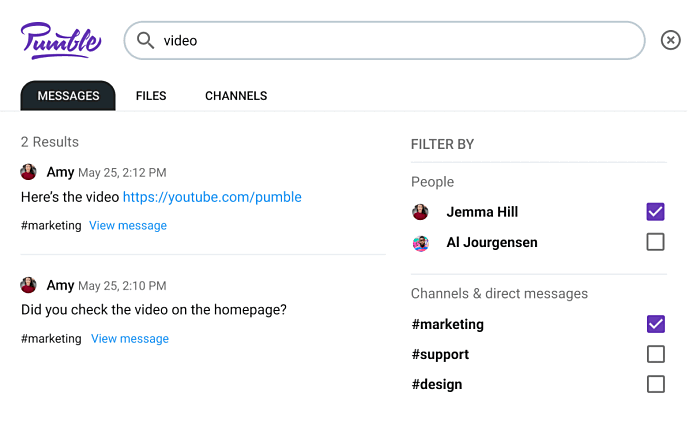
O Pumble oferece histórico de mensagens ilimitado
5. Grupos de usuários com acesso limitado
Este recurso permite que os usuários moderem quais membros da equipe têm acesso a quais informações. Por exemplo, você pode adicionar convidados aos seus espaços de trabalho, como freelancers, fornecedores, clientes e contratados.
🔶 Exemplo:
Vemos aqui que Jemma pode moderar membros e grupos dentro do espaço de trabalho Happy Media no Pumble. Ao selecionar o perfil de Helen, vemos que ela pode acessar os canais "project-alpha" e "design-alpha". Helen é uma contratada, então ela não está autorizada a criar canais ou visualizar canais públicos, então ela não pode acessar informações potencialmente confidenciais. No entanto, ela tem a capacidade de enviar mensagens e arquivos, o que lhe permite colaborar com os funcionários da Happy Media.
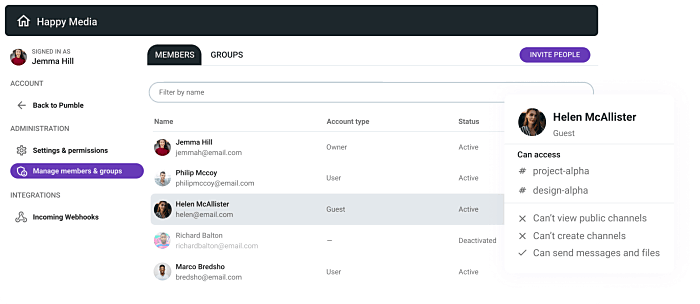
6. Perfis pessoais personalizáveis
Colocar rostos em nomes e títulos torna as conversas mais pessoais. O recurso da tecnologia de colaboração que permite isso é a capacidade de personalizar perfis pessoais. Esse recurso permite que o usuário carregue sua foto, bem como adicione outras informações relevantes.
🔶 Exemplo:
Na captura de tela a seguir, vemos que Jemma carregou sua foto, junto com seu endereço de e-mail, seu número de telefone e sua descrição de trabalho.
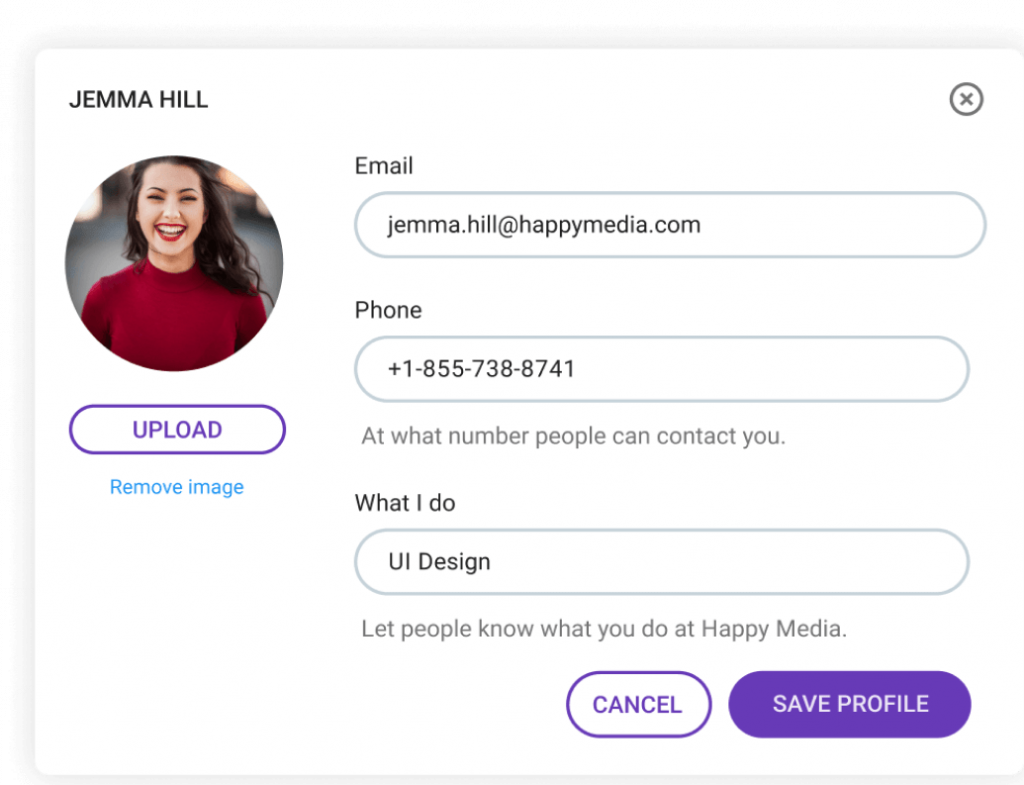
7. Compartilhamento de arquivos
A entrada final nesta lista de recursos importantes da tecnologia de colaboração é o compartilhamento de arquivos. Obviamente, esta é a capacidade de compartilhar arquivos, imagens, vídeos e links com outros membros da equipe — mas também armazená-los em seu espaço de trabalho, para uso futuro.
🔶 Exemplo:
A captura de tela a seguir mostra um canal usado por alunos que frequentam uma aula de química. Nela, vemos que o prof. Stuart compartilhou materiais de aula, um vídeo da aula do dia anterior, junto com uma breve explicação. Assim, os alunos podem encontrar todos os diferentes tipos de arquivos necessários para esta aula em um só lugar.
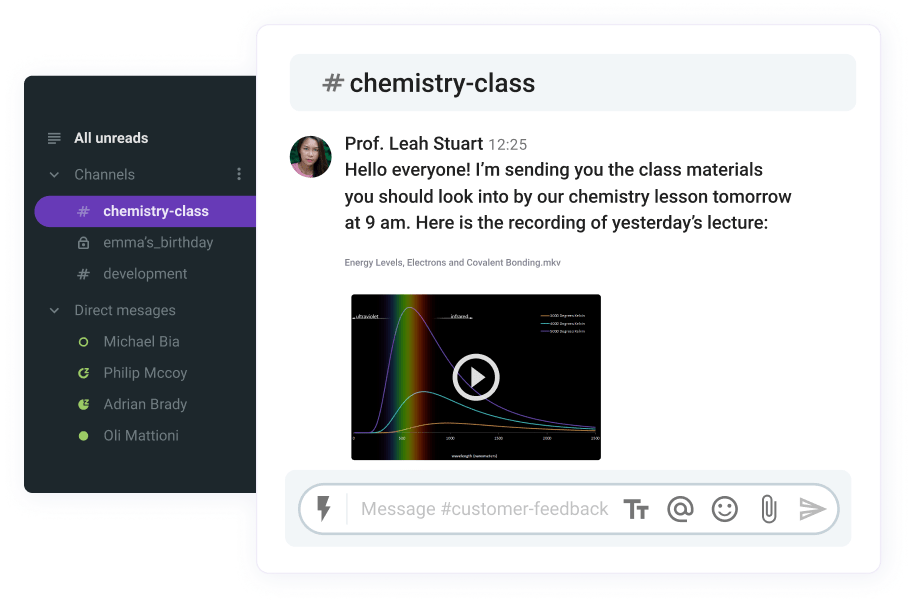
Como medir a eficácia das ferramentas de tecnologia de colaboração usando os cinco atributos da inovação
Uma abordagem para medir a eficácia das ferramentas de colaboração é usar uma pesquisa especializada. Esta pesquisa avalia a tecnologia de colaboração com base na teoria de difusão de inovação de E. Rogers (1995). Em resumo, a teoria propõe cinco atributos de inovações que influenciam a adoção de tecnologia, incluindo vantagem relativa, compatibilidade, complexidade, experimentabilidade e observabilidade.
1. Vantagem relativa
Este fator lida com a forma como os participantes percebem a qualidade do processo de resolução de problemas do grupo e os resultados. As perguntas para avaliar isso incluem:
- "O processo de resolução de problemas do grupo foi eficiente ou ineficiente?"
- "Quão satisfeito ou insatisfeito você ficou com a qualidade dos resultados do seu grupo?"
2. Compatibilidade
Este fator pode ser dividido em dois componentes: compatibilidade entre os membros da equipe e qualidade geral do sistema.
Compatibilidade entre os membros da equipe
Primeiro, temos as perguntas baseadas em como os participantes percebem a qualidade das interações entre os membros da equipe. Então, essas perguntas podem ser:
- “Você ficou satisfeito ou insatisfeito com as discussões do grupo?”
- “Suas interações com seu parceiro/membros da equipe foram livres ou restritas?”
Qualidade geral do sistema
O outro componente da compatibilidade lida com as expectativas do participante sobre a qualidade do sistema. Mas esteja avisado, as seguintes perguntas não se relacionam com a qualidade real do sistema, apenas como ela se compara às expectativas das pessoas:
- “Quão confiável era o sistema?”
- “As operações eram confiáveis ou não?”
- “O tempo de resposta das operações era rápido o suficiente ou muito lento?”
- “O sistema se comportou de maneiras inesperadas?”
3. Complexidade
Este atributo foca na dificuldade percebida de entender e usar uma ferramenta colaborativa. As perguntas para avaliar isso incluem:
- "A interação com o sistema foi frustrante ou não?"
- "No geral, você achou o sistema fácil de usar?"
4. Testabilidade
Este fator é usado para avaliar o nível de facilidade de experimentar o sistema de tecnologia colaborativa. Aqui estão as perguntas:
- "Você acha que é fácil se recuperar de erros neste sistema?"
- "Você achou a exploração de recursos segura ou arriscada?"
5. Observabilidade
Este atributo mostra que tipo de resultados as pessoas observam ao usar a tecnologia colaborativa. As perguntas da pesquisa para avaliar isso incluem:
- "Você aprendeu uma nova maneira de usar a tecnologia com seu parceiro?"
- "Você mudou sua maneira de usar a tecnologia com base no que aprendeu com seu parceiro?"
- "Você encontrou novas maneiras de fazer ciência enquanto trabalhava com seu parceiro?"
Esses cinco atributos são usados como uma estrutura para criar a pesquisa, que pode então ser administrada aos funcionários. Quando os dados forem coletados e analisados, você deverá ter uma ideia bastante precisa de quão eficaz foi a implementação da tecnologia de colaboração.
🎓 Medir a colaboração, em geral, é uma estratégia útil. Você pode aprender mais sobre isso em nosso guia detalhado sobre Métricas de colaboração: como medir a colaboração em uma equipe.
Tendências atuais em tecnologia de colaboração
Com a crise global da COVID-19 de 2020, ocorreu uma grande mudança para o trabalho remoto e híbrido. Junto com essa transição, houve uma necessidade crescente de ferramentas de colaboração para ajudar a habilitar o trabalho para pessoas em diferentes locais. Neste segmento, daremos uma olhada em algumas das tendências atuais mais importantes, expressas em estatísticas sobre o uso da tecnologia de colaboração, atitudes em relação a ela e o valor de mercado das ferramentas de colaboração.
Tendências atuais no uso de tecnologia de colaboração
Podemos primeiro explorar a categoria mais ampla, uma das tendências gerais no uso de tecnologia de colaboração. Aqui estão algumas:
- De acordo com a Pesquisa de Experiência do Trabalhador Digital da Gartner de 2021, desde o início da pandemia, houve um aumento de 44% no uso de tecnologia de colaboração no local de trabalho. Isso totaliza quase 80% de todos os trabalhadores usando ferramentas de colaboração durante 2021.
- Como uma pesquisa da Deloitte mostra, desde o início do bloqueio, 75% dos trabalhadores de escritório relatam usar pelo menos duas novas tecnologias de colaboração para o trabalho.
- De acordo com a Absolute, houve um aumento de 176% na instalação de aplicativos de colaboração em dispositivos da empresa desde o início da pandemia de 2020. Este estudo espera que esse número tenha aumentado nesse meio tempo.
Tendências atuais em atitudes em relação às tecnologias de colaboração
Passando para as atitudes que executivos e funcionários expressaram em relação ao uso da tecnologia de colaboração:
- Uma pesquisa de pulso feita pela Harvard Business Review de 2020 tratou de tornar a tecnologia parte integrante da estratégia de experiência do funcionário. Os participantes citaram estes como pré-requisitos importantes para a colaboração:
- Ferramentas de comunicação — 74% dos participantes;
- Ferramentas de trabalho remoto — 74% dos participantes;
- Ferramentas de colaboração — 67% dos participantes;
- A pesquisa da Deloitte citada anteriormente descobriu que 39% dos executivos acreditam que a implementação de ferramentas de colaboração online é o fator mais importante para tornar o trabalho remoto sustentável. Essa atitude ficou evidente com a crise da COVID-19 e deve continuar no futuro.
- Analisando o estudo Digital 2016 do McKinsey Global Institute, descobrimos que 91% dos trabalhadores pertencentes à Geração Z afirmam que a sofisticação técnica afeta seu interesse em trabalhar em uma empresa.
- Outro estudo, realizado pela Jabra de 2019, descobriu que ferramentas de colaboração eficientes ajudaram a reter os melhores talentos em até 450%.
Tendências atuais no valor de mercado das tecnologias de colaboração
Finalmente, vamos explorar algumas estatísticas financeiras, relacionadas ao aumento do tamanho do mercado e valor para ferramentas colaborativas:
- De acordo com uma estimativa da QY Research, o mercado global de colaboração empresarial aumentará de US$ 25.220 milhões em 2019 para US$ 36.140 milhões até 2026.
- Uma previsão do Apps Run The World de 2020 prevê oaumento do mercado global de colaboração online de US$ 12,4 bilhões em 2019 para US$ 13,5 bilhões em 2024.
- De acordo com uma previsão de 2021 da Business Research Company, o mercado de videoconferência atingirá US$ 8,67 bilhões em valor até 2025.
Com todas essas estatísticas em mente, podemos dizer com certeza que a tecnologia de colaboração veio para ficar e que só podemos esperar mais expansão e transformação no futuro.
Tecnologias de colaboração emergentes: como a tecnologia permitirá o processo de colaboração no futuro?
Tendo visto as tendências que direcionam ao crescimento do mercado de tecnologia de colaboração, podemos ver algumas das implicações que isso tem para o seu futuro. Naturalmente, o crescimento do mercado está fadado a incentivar a inovação e a expansão de novos recursos e soluções tecnológicas. Previsões comuns incluem algumas das maneiras significativas pelas quais o futuro da tecnologia de colaboração mudará: a expansão de soluções de colaboração baseadas em nuvem, a maior integração de IA e o uso de realidade aumentada e virtual.
☁️ A mudança para software baseado em nuvem
Com os eventos de 2020, houve uma mudança pronunciada das empresas para serviços de nuvem pública. Com o aumento do trabalho remoto e a transformação digital subsequente, os serviços baseados em nuvem estão se tornando populares.
De acordo com uma previsão da Gartner, os gastos finais dos usuários de nuvem pública em todo o mundo aumentarão em 23% durante 2021. Essa atividade, no entanto, não se deve apenas à crise da COVID-19, mas a um pico pronunciado em uma tendência que pode ser observada nas últimas duas décadas. Junto com os avanços feitos em tecnologias colaborativas, podemos esperar que a maioria, se não todos os softwares, mudem para serviços de nuvem pública.
🤖 A integração da IA nos negócios
O futuro já está aqui há algum tempo quando se trata do uso de IA nos negócios. No entanto, recentemente começou a ganhar atenção e se tornar mais visível. Algumas das maiores empresas já estão usando IA para aumentar sua produtividade e eficiência. Por exemplo, os varejistas usam o histórico de compras como um insight sobre quais produtos recomendar.
Mais adiante, os especialistas esperam que as empresas usem cada vez mais robôs de IA e Assistentes Pessoais Virtuais Inteligentes (SVAPs) para ajudar a automatizar processos de projetos e melhorar a colaboração no local de trabalho. Mais e mais empresas automatizam tarefas usando ferramentas de IA de automação de processos robóticos. Wearables rastreando funções corporais e IA convertendo-as em dados também oferecem espaço para crescimento e sucesso geral no futuro.
Para resumir, o valor de mercado global deve atingir US$ 190 bilhões e o campo está rapidamente fazendo grandes avanços. Tanto que o crescimento é impedido pela falta de pessoal treinado e experiente. Olhando para isso, podemos dizer com segurança que este é um tipo de tecnologia que está fadado a ultrapassar uma grande parcela das práticas comerciais em geral.
👓 O uso de realidade aumentada e virtual
A fronteira final da tecnologia de colaboração que podemos ver a partir deste ponto no tempo é o uso de Realidade Aumentada (RA) e Realidade Virtual (RV) para simular colaboração intrapessoal.
Ao usar ferramentas de RA, mantemos contato com o mundo físico, mas temos dispositivos que fornecem uma sobreposição informacional adequada ao ambiente. Então, com a ajuda da RA em ambientes empresariais, você pode ter acesso instantâneo a informações e insights relevantes.
Por outro lado, a experiência de RV é totalmente imersiva, fornecida por um dispositivo montado na cabeça. Como tal, ela não permite que você interaja com objetos físicos, mas com objetos virtuais gerados por computador. Esse tipo de tecnologia pode ser usada para treinar pessoas para certas situações e, talvez, a longo prazo, estabelecer locais de trabalho completamente virtuais.
Alguns anúncios de Facebook construindo um "metaverso" baseado em realidade virtual tornam essas previsões mais realistas e iminentes. Aparentemente, estamos nos aproximando do uso de "cópias" virtuais da realidade para colaborar com outras pessoas.
O Pumble é o software ideal para usar para melhorar a colaboração da equipe
À medida que as organizações se esforçam para aumentar a produtividade, promover a inovação e agilizar a comunicação entre os membros da equipe, a escolha do software de colaboração se torna essencial. Entre as opções disponíveis, o Pumble surge como a solução ideal para sua equipe em direção à excelência em colaboração.
Pumble é um software de colaboração em equipe com uma interface amigável e ferramentas abrangentes.
Suas mensagens em tempo real facilitam a comunicação instantânea, enquanto seus canais dedicados permitem discussões focadas em projetos ou tópicos específicos, minimizando distrações.
As ferramentas de videoconferência, compartilhamento de tela e gravação de reuniões do Pumble garantem uma colaboração mais produtiva, mantendo todos sincronizados e permitindo que você faça tudo com rapidez e consistência.
Além disso, o Pumble transcende as fronteiras geográficas, garantindo que todos permaneçam conectados e alinhados em direção a objetivos comuns.
Concluindo, o Pumble se destaca como o software de colaboração por excelência para catalisar o sucesso da sua equipe.
Adote o Pumble e libere todo o potencial de colaboração da sua equipe — crie uma conta hoje mesmo.
Como avaliamos esta publicação: Nossos escritores e editores monitoram as postagens e as atualizam quando novas informações ficam disponíveis, para mantê-las atualizadas e relevantes.



